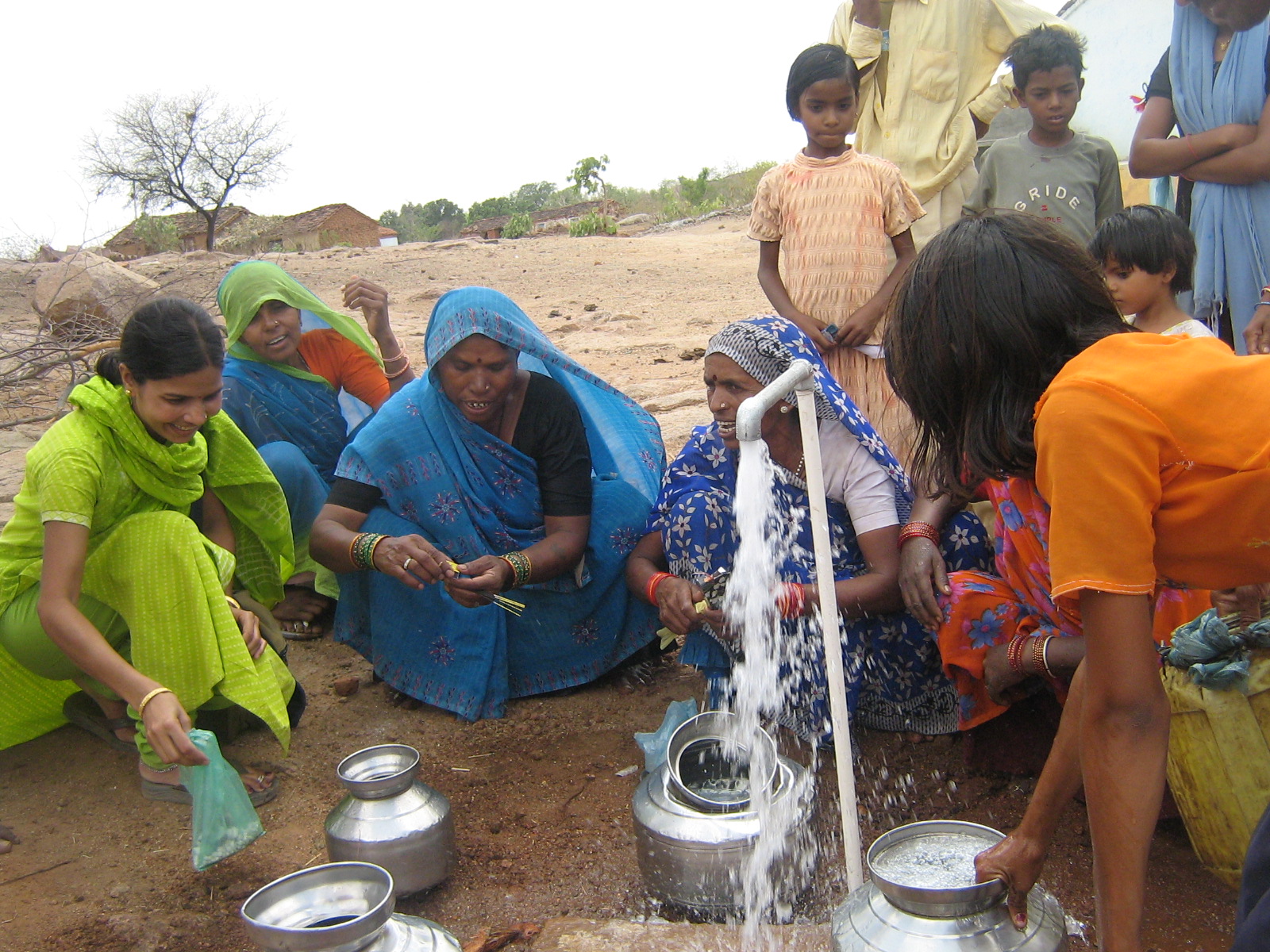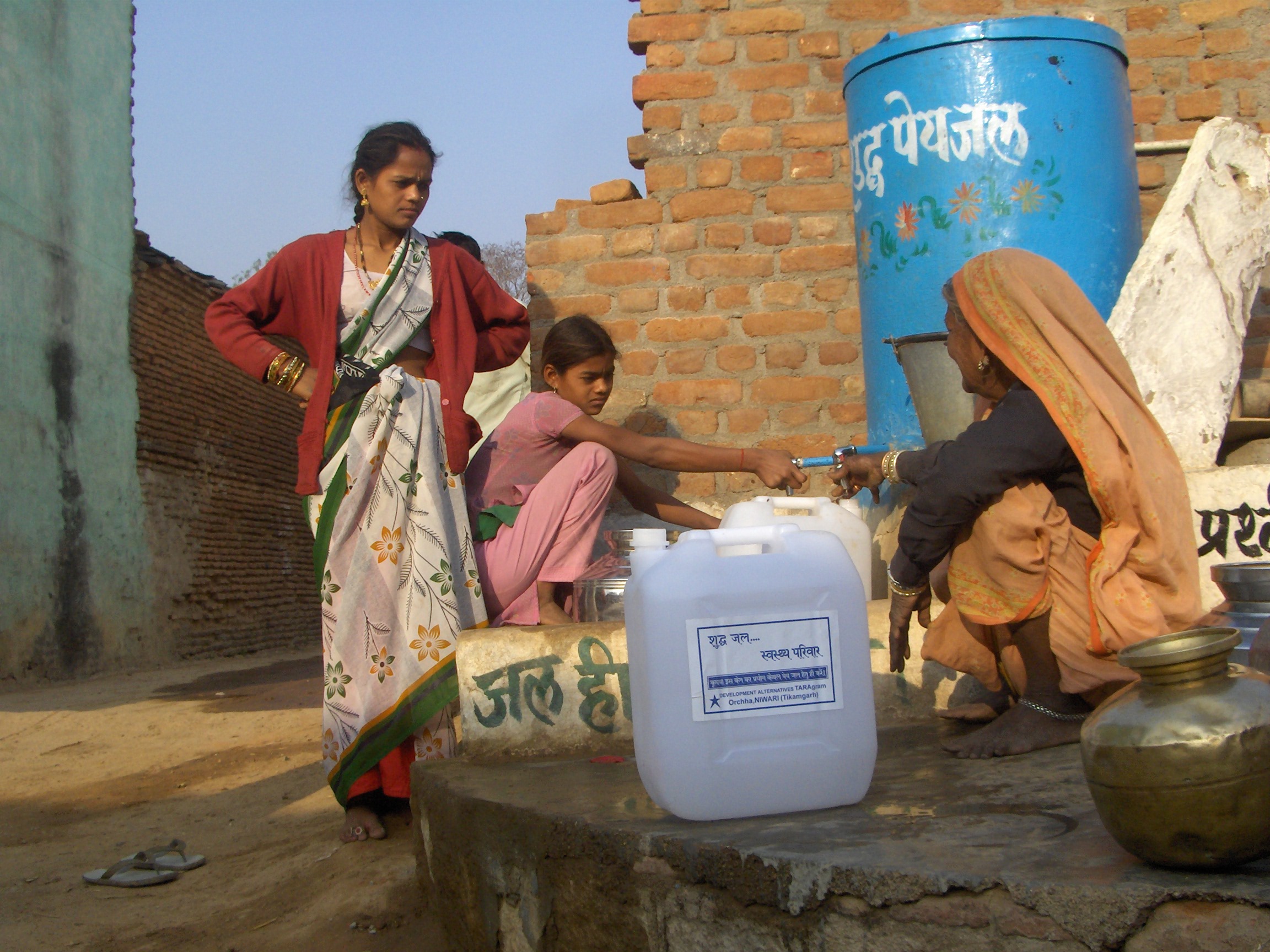| Women and Water in Bundelkhand  Bundelkhand region in central India comprises 13 contiguous districts, seven in Uttar Pradesh (UP) and six in Madhya Pradesh (MP). Resting on a vast granite massif, the landscape is undulating and semi-rocky and the average annual rainfall in this area is about 850 mm. The economy is mostly agricultural. Bundelkhand was once home to a succession of enlightened kingdoms through the millennia. The kings of the Bundela dynasty built and maintained innumerable rainwater harvesting structures, which ensured abundant supplies of water throughout the year. The people of this region followed a pastoral economy with rich pasture lands. There was low human and animal population and animal husbandry was the mainstay of income. The water bodies were mostly tanks (small, medium and large) which filled up during the rainy season and, in turn, charged the groundwater. Thus, the wells in the village had plenty of water throughout the year. Even in the years when the monsoon was below normal, there was no shortage of drinking water for humans and animals. But the situation is completely changed now. For most of the year, the residents of Bundelkhand experience acute scarcity of water for agricultural and domestic use. Water sources are varied and often seasonal, ranging from ponds, tanks, lakes and streams to open wells, bore wells and irrigation canals radiating out from large-scale dams. Most agriculture is of the single-crop variety and rain fed, with supplementary water from open wells. Thus, a large number of farmers are highly dependent on the monsoon rains to recharge these wells. Women play a central role in village and family life, and are usually responsible for preparing meals and fetching water, in many cases, walking long distances to collect water for their families. Water solutions should give every woman a reliable source of drinking and domestic water along with a toilet in her home, to release her from drudgery and let her participate in the economy. Women, traditionally being responsible for procuring water for domestic purposes, are the worst affected of the lot in the wake of severe water crisis. They have to walk for miles to draw water from the drying hand pumps and wells in addition to carrying out household chores. They also carry out economically productive activities like livestock rearing and working in the fields. And, when water is not readily available, they have to wake up earlier than usual to walk even longer distances or stand in queues. Children, mostly girls, are equally engaged in meeting the water requirements of the families, directly or indirectly. In some cases, while mothers are away in search of water, their girl children are taking care of housework or the younger siblings. This is a major hurdle in the growth and development of children from the perspective of not only play time but also education. There are reports and instances where children have been dismissed from schools for being irregular, as a result of long hours spent in fetching water. All this while, barring some exceptions, men in most of the villages while away their time gambling on the streets. It is a very common sight in these villages to see men sitting in groups, playing cards or chatting away, while women and children are constantly engaged in fetching water. No wonder that during discussions, many debates have sparked off a reaction from men when water crisis was highlighted as a priority issue by the women and children, prompting the latter to say ‘jeeke paon phateen na bimai, bo ka jaane peer parai’ meaning those who haven’t cracked their heels working, do not understand the toil of others. In most of these villages, it is mainly the women who have formed self-help groups and taken the onus upon themselves to initiate the community participation with the help of the field workers. Ganeshgarh from Jhansi in Uttar Pradesh and Pipra from Tikamgarh, Madhya Pradesh are significant examples in this regard. Apart from these glaring aspects of drought that can be seen, there are some not so obvious ones like the collapse of socio-cultural systems of the people. In most of the villages, women and girl children fetch water from distant sources for both cooking and drinking. Due to lack of water, basic sanitation has resulted in many health problems. During discussions, women mentioned that they had to wait for the darkness either in the early mornings or in the nights to relieve themselves out in the open. This causes many ill-effects to their reproductive health. As in the case of other drought-hit regions, Bilt Tapariyan showed evidence of skin diseases like scabies, mostly amongst children. Realising the very need, ‘Water for All and Always’, a collaborative effort of Development Alternatives (DA) and the Arghyam Trust applied their resources towards finding appropriate solutions in meeting the qualitative and quantitative requirements of basic services like water and sanitation in rural Bundelkhand, with pilot projects in ten villages of Jhansi and Tikamgarh districts. The project is designed to provide solutions for an Integrated Water Resources Management (IWRM) and drawing lessons for multiplication. Given the background of Bundelkhand region and the key concerns mentioned above, the approach was to build around the issue of sustainability in terms of both source creation and its management (quality and quantity), and building of institutional systems at various levels (villages, blocks, district levels) for community based management of water challenges. An integrated approach to water management was taken into consideration. The supply of water and its management has been carried out through the conservation approach by integrating the development of water resources through intensive community participation. The approach has strived to reduce the existing imbalances between the demand and supply of water through community driven mechanisms. Restoration, conservation and sustainable utilisation of the resource base has been the thrust area. Implementation of different activities for providing access to safe drinking water and better sanitation facilities has been carried out by involving the main stakeholders. Local institutions have been mobilised and awareness activities have been undertaken through various outreach programmes, workshops and extension activities. This has ensured effective participation of the communities in managing and maintaining water conservation practices and natural resources management initiatives as per the action plan. The women and village youth have been trained to test their water and install Jal-TARA water purification systems (works on the principal of Slow Sand Filtration technique, developed by DA) in the villages to purify bacterial contamination which is the main problem in the region. Impacts So Far  There has been considerable change observed in the lives of people in these villages. Currently, women from these villages are enjoying the freedom from drudgery and diverting their efforts for productive employment such as food processing, poultry rearing, etc., to raise their income levels. In these villages, women and the village committees are involved in collecting the user charges for the water supplied, besides installing water meters (volumetric measurement) to keep the check on excessive consumption and then applying user charges as per the quantities drawn. In Madore village (MP part of Bundelkhand region), while the water delivery enterprise is set up by the community, in Kachipura village the water enterprise is set up by an individual entrepreneur. Women self help groups are playing a major role in regulating all these efforts. In partnership with these community groups, there is a considerable reduction in the morbidity rate due to better quality water. Conclusions Here, the initiative carried forward by DA and Arghyam Trust is just a beginning towards helping communities access potable water. In the scheme of things, this is just a small step forward. Therefore, the following suggestions can be taken into consideration: • There should be recognition that women play a central role in the provision, management and safeguarding of water • Women and men community representatives should be encouraged to openly monitor the participation of key groups in the community • Gender-sensitive approaches to water resources management are desirable for achieving efficiency, social equity and gender-equality goals. Targets such as those in the Millennium Development Goals (MDGs) relating to water are unlikely to be achieved unless gender perspectives are integrated into planning and implementation activities q M Manoj Kumar
|